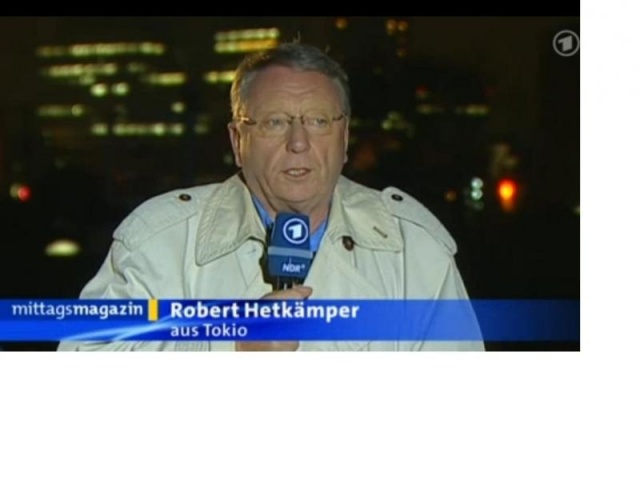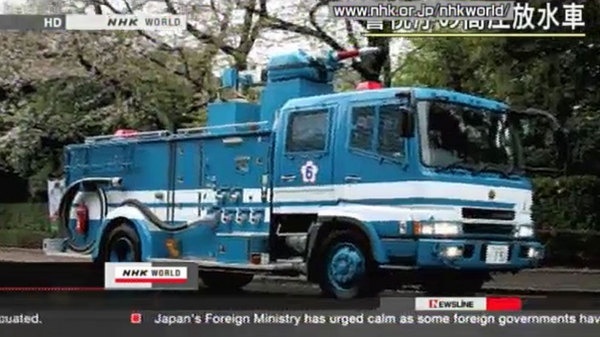- Politik
- Mitteilungen Wahlfieber-Team
- USA
- Schweiz - Liechtenstein
- Neue Märkte
- Prognosen und Ergebnisse (D-A-CH)
- Wahlauswertungen Deutschland
- Auswertungen Österreich - Schweiz
- Auswertungen Europa
- Auswertungen weltweit
- Auswertungen Präsidentschaftswahlen
- Prognosen und Ergebnisse (USA)
- Fußball und andere Themen
- Interview-Forum
Bebt die Erde verstärkt? Erdbeben 8,8 in Japan
-
"Allerdings besteht in Japan ein enger Zusammenhang für die Erdbeben- und Tsunamiopfer: Für sie kann offenkundig nicht genug getan werden, weil die Ressourcen des Landes und weltweit wegen der Kernschmelze in den AKWs nicht auf ihre Rettung bzw. Hilfe für sie fokussiert werden können. Darüber muss m.E. hier und anderswo mehr gesprochen werden!"
Es geht hier eben auch um ökonomische Langzeitkosten. Der Bodycount ist natürlich bei Tsunami und Erdbeben um ein Vielfaches höher, als er durch die Kernschmelzen sein wird. Bei den ökonomischen Kosten dürfte es umgekehrt sein, und die sind im Gegensatz zur Erdbeben und Flut nicht versichert. Wenn z.B. alleine die aus 20km Evakuierten (200 000) für 60 Jahre nicht mehr in ihre Häuser können (und der Radius dürfte noch wachsen) wird das teurer als bei den Toten, die nicht mehr viele Kosten verursachen. Dazu kommen horrende Kosten für Beseitigung und Entgiftung, den Wiederaufbau der Stromproduktion, die Pleite von Tepco, Schäden für Bauern und Fischer, etc. Es werden ja derzeit meiner Meinung nach auch 50 bis 750 Techniker geopfert, um va. die ökonomischen Kosten zu begrenzen. Man könnte das Gebiet ja auch verlassen und großräumiger evakuieren, das würde Menschenleben retten, wäre aber teuer. Die Russen haben damals angeblich über 50.000 Menschen ("Liquidatoren") in den Tod geschickt, ohne die Folgen von Tschernobyl maßgeblich mindern zu können. Darüber sollte man mal sprechen. Die gehen für ihre Manager, Aktionäre und Mitbürger in den Tod wie Kamikaze früher für ihren Kaiser.
-
Was oft übersehen wird. Es geht hier nicht nur um die Strahlung, sondern um Kontamination und Ingestion in Lebewesen. Deshalb drehte die amerikanische Flotte zunöchst ab oder wird US-Soldaten nur eine Annäherung auf 80 km an die Reaktoren gestattet.
Es geht sogar NUR um Kontamination mit radioaktiven Elementen. Wie stellt ihr euch das vor, dass γ-Strahlung den Reaktor verlässt und dann um's Eck fliegt?
ums japanische eck nicht, aber vielleicht hierher nach deutschland. vielleicht sogar, um asyl zu beantragen.
-
http://edition.cnn.com/2011/WORLD/asiapcf/03/16/japan.nuclear.reactors/index.htm l?hpt=T1
Ich hatte eben Gelegenheit ein wenig CNN zu schauen.
Was auffällt: US-Reporter gehen auf die Strasse, kraxeln durch die Trümmer und reden mit echten Japanern! Dazu gibt es Aufsager und Experten.
Bei uns steht Hettkämper in Tokio im immergleichen Trenchcoat auf irgendeinem Dach vor blinkenden roten Lichtern und erzählt, was die Agenturen hergeben.
Was ich ändern würde: Reporter über 50, die nicht mehr vor die Tür gehen kommen nach Hause!
Zur Lage: CNN berichtete von einer letalen Strahlung in einigen Teilen des Kraftwerks, die wohl von US-Experten vor Ort ermittelt wurde, was der bisherigen Darstellung der Betreiberfirma widerspricht. Bisher hatten die US-Experten die ergriffenen Massnahmen voll unterstützt. Nachdem sie das Werk mit eigenen Augen gesehen haben beginnen sie sich zu distanzieren.
Sichtbar wurde dies auch an der neuen Evakuierungsanweisung an US-Amerikaner, die allein nach in den US gültigen Kriterien festgelegt wurde.
Clinton-Interview:
http://edition.cnn.com/video/data/2.0/video/world/2011/03/16/tsr.blitzer.clinton .japan.cnn.html
Die US-Experten haben selbst nachgemessen, denn es macht einfach fertig den Japanern auf ihren Pressekonferenzen alles aus der Nase zu ziehen.
http://www.spiegel.de/panorama/0,1518,751191,00.html
[00.16 Uhr] Die internationale Atomenergiebehörde IAEA hat Informationen zur Wassertemperatur in den Unglücksreaktoren des havarierten Atomkraftwerks Fukushima 1 veröffentlicht. Demnach betrug die Temperatur des Kühlwassers im Abklingsbecken des Reaktors 4 am Dienstagmorgen 84 Grad Celsius. Am Mittwochmorgen seien im Reaktor 5 rund 62 Grad sowie 60 Grad im Reaktor 6 gemessen worden. Normalerweise wird die Wassertemperatur unter 25 Grad gehalten. In den Abklingbecken lagern die bereits verbrauchten, abgebrannten Brennelemente, die aber ohne entsprechende Kühlung ähnlich gefährlich sind wie die aktiven Elemente im Reaktorkern. Im Reaktor 4 des AKW Fukushima liegt das Abklingbecken außerhalb des besser geschützten Sicherheitsbereiches - daher ist die Gefahr besonders groß. Aktuelle IAEA-Berichte sagen, das Wasser in den Reaktoren 3 und 4 würde mittlerweile kochen. Die US-Atombehörde geht sogar davon aus, dass sich im Reaktor 4 gar kein Wasser mehr befinde (s. Liveticker von 22.22 Uhr).
[22.22 Uhr] Im Abklingbecken des Reaktors 4 im japanischen Katastrophen-Kraftwerk Fukushima 1 befindet sich nach Einschätzung der US-Atomregulierungsbehörde NRC gar kein Wasser mehr. Damit liegen die Brennstäbe im Reaktor 4 möglicherweise komplett frei. Man gehe davon aus, dass das Abklingbecken defekt und das Wasser abgelaufen sei, sagte NRC-Direktor Gregory Jaczko in einer Anhörung vor einem Kongress-Ausschuss laut einem Bericht der "New York Times". "Wir glauben, dass die Strahlenbelastung extrem hoch ist", sagte Jaczko. Dies wiederum könnte die Arbeit zur Eindämmung der Krise behindern. Über die Quelle der Information machte Jaczko keine Angaben. Die NRC sowie das US-Energieministerium haben Experten vor Ort.
Sollten sich die Angaben als zutreffend erweisen, würde dies bedeuten, dass die Brennelemente in dem Abklingbecken nicht mehr gekühlt werden und somit schmelzen könnten. Außerdem droht die Gefahr, dass sich die Stäbe selbst entzünden könnten. Die japanische Atomsicherheitsbehörde und der Kraftwerkbetreiber Tepco dementierten, dass die Wassermenge in dem Abklingbecken abgenommen habe. Die Lage an Reaktor 4 sei "stabil", sagte ein Sprecher.
-
http://edition.cnn.com/2011/WORLD/asiapcf/03/16/japan.nuclear.reactors/index.htm l?hpt=T1 [cnn.com]
Ich hatte eben Gelegenheit ein wenig CNN zu schauen.
Was auffällt: US-Reporter gehen auf die Strasse, kraxeln durch die Trümmer und reden mit echten Japanern! Dazu gibt es Aufsager und Experten.
Bei uns steht Hettkämper in Tokio im immergleichen Trenchcoat auf irgendeinem Dach vor blinkenden roten Lichtern und erzählt, was die Agenturen hergeben.
hetkämper berichtet mittlerweile aus osaka.
ich überlege, ob ich ein schreiben an den ndr schicke, um mich als wien-korrespondent des ndr zu bewerben. tenor: über alle aktuellen politischen entwicklungen in österreich werde ich live aus norddeutschland berichten. sozusagen fast direkt vom ort des geschehens.
mein appell: hetkämper nach fukushima. ab vors brennende akw mit ihm! aber fix!
könnte jemand bitte eine entsprechende gruppe bei facebook einrichten.
-
Da ramana schon so pingelig ist - ein paar Relationen zum Einschätzen der Zahlen, mit denen berufene und unberufene Experten so um sich werfen und die verbundenen Gefahren und Auswirkungen:
Effective Dose
Effects of Radiation Levels on the Human Body
50 mSv ≤ E(Sv) < 200 mSv
Possible late effects; possible chromosomal damage.
200 mSv ≤ E(Sv) < 1 Sv
Temporary reduction in white blood cells.
1 Sv ≤ E(Sv) < 2 Sv
Mild radiation sickness within a few hours: vomiting, diarrhea, fatigue; reduction in resistance to infection.
2 Sv ≤ E(Sv) < 3 Sv
Serious radiation sickness effects as in 100-200 rem and hemorrhage; exposure is a Lethal Dose to 10-35% of the population after 30 days (LD 10-35/30).
3 Sv ≤ E(Sv) < 4 Sv
Serious radiation sickness; also marrow and intestine destruction; LD 50-70/30.
4 Sv ≤ E(Sv) < 10 Sv
Acute illness, early death; LD 60-95/30.
10 Sv ≤ E(Sv) < 50 Sv
Acute illness, early death in days; LD 100/10.
Quelle: http://www.atomicarchive.com/Effects/radeffectstable.shtml (dort ist die Tabelle noch in rem!)
So und das sagt auch keiner, der so geláufig mit Zahlen um sich wirft.
Physikalisch einfach ist in Gray zu messen, das eine Energie.
Sievert is eine äquivalente Dosis (die die biologische Auswirkung misst). Die Berechnung ist kompliziert. Es geht ein: Typ der Strahlung (gamma, beta, alpha, neutron), die Energie, und dann kommt eine Gewichtung dazu die abhängigt von der Art der Belastung, d.h. external exposure (Kontakt) oder internal exposure (Einatmung wird anders berwertet als Nahrungsaufnahme, ingestion) und welches Organ betroffen ist (Darm und Lunge sind 2,4 mal höher gewichtet als Leber oder Schilddrüse)....
Eine Daumenregel für Krebs
[genaue Zahlen kennt keiner, u.a streitet man sich, ob es einen Grenzwert gibt (threshold), ob die Abhánigkeit dann linear oder quadratisch oder supralinar ist]
•The risk of cancer due to DNA damage increases with the dose.
•This risk is estimated at 5 % for 1000 mSv cumulated dose.
-
Ab Morgen geht auch er. Ich erwarte, dass er seinen trenchcoat, ene Art Strahlenschutz, in Tokio zurücklässt, der Held.
Das was er macht, kann man in der Tat von jedem Ort der Welt leisten. Ich habe keinen einzigen von ihm produzierten Beitrag in den letzten Tagen gesehen.

-
Epizentrum: LAT 39.165 LON 142.661
Fukushima, Hokkaido, Japan (Latitude: 41° 28' 29 N, Longitude: 140° 15' 19 E
Es ist zu befürchten, dass dies daher fast ungemindert in Fukushima gespürt wurde
-
http://politicalticker.blogs.cnn.com/2011/03/16/pelosi-describes-japan-tragedy-a s-beyond-biblical/
House Democratic Leader Nancy Pelosi on Wednesday described the earthquake, tsunami and nuclear crisis in Japan as "beyond biblical in terms of its proportion."
das Copyright an dieser meiner Wortschöpfung schenke ich Erich Haiderer, Korrespondent für das Paranormale

-

Letze Idee der Betreiber
Oder, mein Vorschlag:

http://www.youtube.com/watch?v=Z8DSNGOIPVE
Ganze Folge - Grisu - Der Kernphysiker ---------- Prophetisch lustig!
-
MUST READ
"If they don't get water to these spent fuel pools in view of the containment breaches in the other plants the actual radiation releases could approach that category of Chernobyl," said Victor Gilinsky, who was an NRC commissioner at the time of the Three Mile Island accident in 1979, which was the worst nuclear accident in U.S. history.
Earlier Japanese authorities told the International Atomic Energy Agency that radioactivity was being released directly into the air at the pool for the No.4 reactor at the Fukushima Daiichi plant. Experts say the pools could present a bigger threat to public health than the reactors, which appear to be still encased in steel containment systems.
"Up until now they have not been able to get close to the spent rods, as even with protective clothing it only stops workers from breathing in radioactive particles, not from radiation itself," Dr Peter Hosemann PHD of the University of California Berkeley Nuclear Engineering Department said Tuesday.
While the building holding the rods has been rocked by fire and a blast, officials in Japan had not said how much water remained in the 40-foot deep tanks.
James Acton, Associate in the Nuclear Policy Program at the Carnegie Endowment for International Peace, said in an interview before Jaczko's comments that it appeared there was a leak in the pool.
"There is either a leak in the spent fuel pool or the rods are hot enough to cause evaporation," Acton said.
DEADLY MIX
When a fuel rod is exposed to the air the zirconium metal cladding on the rods can easily catch on fire, releasing a deadly mix of radiation into the atmosphere. The earlier fires and explosion in the area of the spent fuel storage tank left the pool partly open to the air allowing the radiation to escape into the atmosphere.
Experts say the water should remain at least eight feet over the spent fuel to maintain acceptable radiation levels but the level usually is kept much higher.
"As the water drains there's going to be less stability - and higher levels of radiation released," said Tara Neider, President and CEO of Areva Federal Services, a U.S. arm of the world's biggest nuclear power plant builder, French giant Areva SA.
Tokyo Electric Power Co (TEPCO), the operator of the six-reactor complex, was considering spraying water into the spent fuel pools through the holes in the roof by helicopter but later canceled that mission.
Arnie Gundersen, a 29-year veteran of the nuclear industry who has worked on reactors similar to the Daiichi plant and is now chief engineer at Fairewinds Associates Inc, warned that dropping water on the spent fuel pool could make matters worse.
"It's a bad idea to drop water onto the fuel racks. You could get an inadvertent criticality. That means you could have a nuclear reaction, similar to that in a reactor core, in the fuel pool," Gundersen said.
MORE RADIATION
"There is more radiation in the spent fuel pool - which is about ten stories in the air -- than in the reactor core," Gundersen said, noting used rods contain more dangerous radioactive materials than new rods, including elements cesium, strontium and plutonium.
Plutonium, in particular, is a very nasty isotope and could cause cancer in very small quantities if ingested, he said.
The uranium fuel is burned in the reactor for three to six years before being placed into the pool. About one third of the fuel is removed from the reactor core to the pool every 18 to 24 months during refueling outages.
Used fuel rods must sit in the spent fuel pool for at least five years. Though, much to the consternation of environmental and anti-nuclear groups, the rods usually sit in the pool much longer while waiting for either reprocessing or storage in dry casks.
Gundersen also said he recommended evacuating children and pregnant women to more than 50 miles away from the plant to avoid the radiation risk.
In a sign that other spent fuel rod pools could be in a deteriorating condition, the NRC Chairman Jaczko said he also believed the pool at the No. 3 reactor may also have a leak.
"Every day it seems like things may be stabilizing but you wake up the next morning and it seems like things have not stabilized or maybe gotten worse," said Brian Woods, nuclear engineering associate professor at Oregon State University and a former engineer for the U.S. Department of Energy.
Woods said that it may be time to think of encasing the complex in some kind of protective material.
"More than likely you're probably looking at some kind of external containment," he said.
Wer noch nicht genug schlechte Nachrichten hat - hier eine weitere Dosis:
http://edition.cnn.com/2011/WORLD/asiapcf/03/16/japan.nuclear.reactors/index.htm l
In Washington, military officials said they had deployed an atmospheric detection aircraft, the WC-135W Constant Phoenix, to assist in detecting radioactive materials in the atmosphere around Japan.
The plane, normally based at Offutt Air Force Base in Nebraska, was moved Tuesday to Eielson Air Force Base in Alaska to prepare for its first sortie, the officials said.
The aircraft can "detect radioactive 'clouds' in real time," according to the Air Force.
...
The water served to both cool the uranium fuel and shield it. But once the uranium fuel was no longer covered by water, the zirconium cladding that encases the fuel rods heated, generating hydrogen, said Robert Alvarez, senior scholar at the Institute for Policy Studies and a former official with the Department of Energy.
That caught fire, resulting in a situation that is "very, very serious," he told CNN. He said the next step may involve nuclear plant workers taking heroic acts. Asked to be more specific, he said, "This is a situation where people may be called in to sacrifice their lives. ... It's very difficult for me to contemplate that but it's, it may have reached that point."
Fine music for political ears
What we predict...
Wahlfieber, originally a platform from the German-speaking world, offers (user-based) forecasts on elections worldwide - using political prediction markets without applying any algorythm.
Our focus
Germany / Austria / Switzerland
All national and state elections as well as selected local, mayoral and party elections
Europe
Almost all national elections as well as selected presidential, regional and local elections and votes.
USA
All presidential, senatorial and house elections (including mid-term and most presidential primaries/caucusses) as well as important special and state elections.
UK
All national and state elections as well as important special, local and mayoral elections and votes.
Worldwide
National elections - including Australia, Canada, Israel, Japan, New Zealand, etc.
Important elections in 2025
- Several state elections in Germany, Austria, Switzerland and Liechtenstein
- Presidential elections in Romania, Poland, Ireland, Portugal
- National elections in Germany, Czech Republic, Netherlands, Norway - Argentina, Australia, Canada
How does this work?
This is how you contribute to the prediction - See the Infocenter
Found an error?
Your Feedback?
Please send error messages and feedback by email to: help@wahlfieber.com
